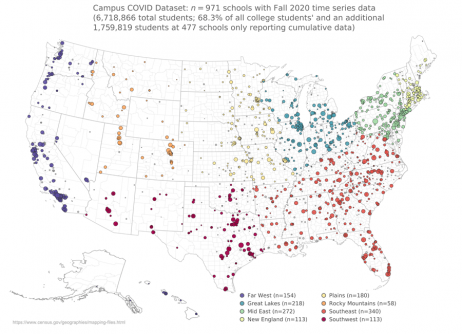With a dataset of testing and case counts from over 1,400 institutions of higher education (IHEs) in the United States, Klein, et al. (2022) analyzed the number of infections and deaths from SARS-CoV-2 in the counties surrounding these IHEs during the Fall 2020 semester (August to December, 2020). The researchers found that counties with IHEs that remained primarily online experienced fewer cases and deaths during the Fall 2020 semester; whereas before and after the semester, these two groups had almost identical COVID-19 incidence.
Additionally, they saw fewer cases and deaths in counties with IHEs that reported conducting any on-campus testing compared to those that reported none. To perform these two comparisons, the researchers used a matching procedure designed to create well-balanced groups of counties that are aligned as much as possible along age, race, income, population, and urban/rural categories—demographic variables that have been shown to be correlated with COVID-19 outcomes.
They conclude with a case study of IHEs in Massachusetts—a state with especially high detail in our dataset—which further highlights the importance of IHE-affiliated testing for the broader community. The results in this work suggest that campus testing can itself be thought of as a mitigation policy and that allocating additional resources to IHEs to support efforts to regularly test students and staff would be beneficial to mitigating the spread of COVID-19 in a pre-vaccine environment.
Reference: Klein B, et al. Higher education responses to COVID-19 in the United States: Evidence for the impacts of university policy. PLOS. June 23, 2022. https://doi.org/10.1371/journal.pdig.0000065
Source: PLOS
